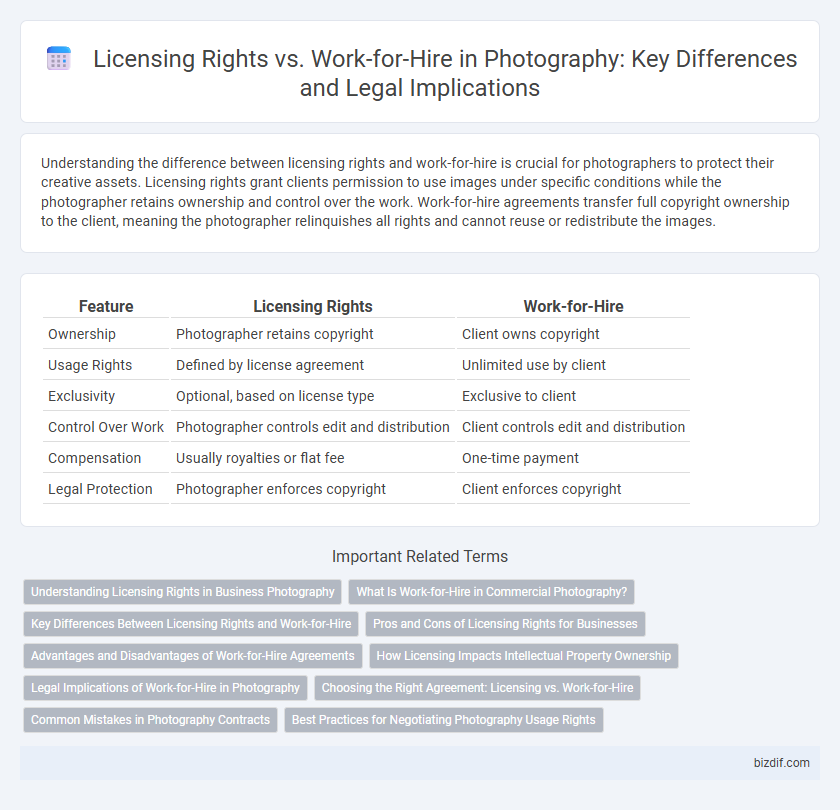Understanding the difference between licensing rights and work-for-hire is crucial for photographers to protect their creative assets. Licensing rights grant clients permission to use images under specific conditions while the photographer retains ownership and control over the work. Work-for-hire agreements transfer full copyright ownership to the client, meaning the photographer relinquishes all rights and cannot reuse or redistribute the images.
Table of Comparison
| Feature | Licensing Rights | Work-for-Hire |
|---|---|---|
| Ownership | Photographer retains copyright | Client owns copyright |
| Usage Rights | Defined by license agreement | Unlimited use by client |
| Exclusivity | Optional, based on license type | Exclusive to client |
| Control Over Work | Photographer controls edit and distribution | Client controls edit and distribution |
| Compensation | Usually royalties or flat fee | One-time payment |
| Legal Protection | Photographer enforces copyright | Client enforces copyright |
Understanding Licensing Rights in Business Photography
Licensing rights in business photography grant specific permissions for how images can be used, defining scope, duration, and exclusivity without transferring ownership. Unlike work-for-hire agreements where the client owns the final images outright, licensing allows photographers to retain copyright while monetizing usage rights. Understanding these distinctions ensures clear contractual agreements, protecting both the photographer's intellectual property and the client's operational needs.
What Is Work-for-Hire in Commercial Photography?
Work-for-hire in commercial photography means the photographer's images are legally owned by the client from the moment of creation, with no transfer of copyright required. Unlike licensing rights, where usage is limited and controlled by the photographer, work-for-hire grants the client full and exclusive ownership, allowing unrestricted use, modification, and distribution. This agreement is essential for businesses needing complete control over images without ongoing licensing negotiations or royalties.
Key Differences Between Licensing Rights and Work-for-Hire
Licensing rights grant the photographer control over how their images are used, allowing clients specific permissions without full ownership transfer. Work-for-hire agreements legally transfer copyright ownership to the client, making them the sole owners of the photographs. The key difference lies in copyright retention: licensing maintains the photographer's authorship rights, while work-for-hire relinquishes these rights to the client.
Pros and Cons of Licensing Rights for Businesses
Licensing rights offer businesses flexibility and ongoing revenue potential by allowing them to use photographers' work without full ownership, reducing upfront costs compared to work-for-hire agreements. However, licensing restrictions can limit how images are used, potentially requiring renegotiation for extended or varied use, which may complicate marketing strategies. Relying solely on licensing rights may expose businesses to risks if agreements are not clear, unlike work-for-hire where the business gains complete control over the created content.
Advantages and Disadvantages of Work-for-Hire Agreements
Work-for-hire agreements grant the employer full ownership of photographs, eliminating disputes over copyright and enabling seamless commercial use without additional fees. However, photographers sacrifice control over their creative work and lose potential revenue from future licensing or resale opportunities. This arrangement suits clients requiring exclusive rights but may limit the photographer's ability to build a personal portfolio or capitalize on their images independently.
How Licensing Impacts Intellectual Property Ownership
Licensing rights in photography grant specific usage permissions while the photographer retains intellectual property ownership, allowing control over how images are used, copied, or distributed. In contrast, work-for-hire agreements transfer full copyright ownership to the client, relinquishing the photographer's control over the images. Understanding licensing impacts ensures photographers can protect their creative rights and monetize their work effectively.
Legal Implications of Work-for-Hire in Photography
Work-for-hire agreements in photography legally assign copyright ownership to the client rather than the photographer, effectively transferring all usage rights and control over the images. This legal structure prevents photographers from claiming future royalties or licensing fees, significantly impacting their long-term revenue potential. Understanding the legal implications of work-for-hire contracts is crucial to protect photographers' intellectual property rights and ensure clarity in ownership and usage terms.
Choosing the Right Agreement: Licensing vs. Work-for-Hire
Choosing the right agreement in photography hinges on understanding the distinctions between licensing rights and work-for-hire contracts. Licensing grants clients limited usage permissions while retaining copyright ownership with the photographer, enabling future control and revenue opportunities. Work-for-hire transfers full copyright to the client, making them the legal author, which is ideal for projects requiring exclusive ownership but limits the photographer's rights.
Common Mistakes in Photography Contracts
Misunderstanding the distinction between licensing rights and work-for-hire agreements often leads photographers to unintentionally relinquish full ownership of their images. Common mistakes in photography contracts include failing to specify usage rights clearly, which can result in clients using photos beyond the agreed scope without additional compensation. Photographers should always ensure contracts explicitly outline whether they retain copyright or transfer it entirely to avoid disputes and protect their creative control.
Best Practices for Negotiating Photography Usage Rights
When negotiating photography usage rights, clearly define whether the agreement is a license or a work-for-hire contract to establish ownership and usage scope. Specify the duration, geographic area, and media formats in which the images can be used to protect both parties' interests. Consult standard contracts like ASMP or Getty Images agreements to ensure fair compensation and avoid disputes over intellectual property rights.
Licensing rights vs Work-for-hire Infographic

 bizdif.com
bizdif.com